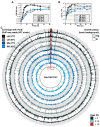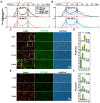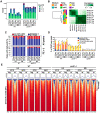Robust ParB Binding to Half- parS Sites in Pseudomonas aeruginosa-A Mechanism for Retaining ParB on the Nucleoid?
- PMID: 37569892
- PMCID: PMC10419367
- DOI: 10.3390/ijms241512517
Robust ParB Binding to Half- parS Sites in Pseudomonas aeruginosa-A Mechanism for Retaining ParB on the Nucleoid?
Abstract
Chromosome segregation in Pseudomonas aeruginosa is assisted by the tripartite ParAB-parS system, composed of an ATPase (ParA), a DNA-binding protein (ParB) and its target parS sequence(s). ParB forms a nucleoprotein complex around four parSs (parS1-parS4) that overlaps oriC and facilitates relocation of newly synthesized ori domains inside the cells by ParA. Remarkably, ParB of P. aeruginosa also binds to numerous heptanucleotides (half-parSs) scattered in the genome. Here, using chromatin immunoprecipitation-sequencing (ChIP-seq), we analyzed patterns of ParB genome occupancy in cells growing under conditions of coupling or uncoupling between replication and cell division processes. Interestingly, a dissipation of ParB-parS complexes and a shift of ParB to half-parSs were observed during the transition from the exponential to stationary phase of growth on rich medium, suggesting the role of half-parSs in retaining ParB on the nucleoid within non-dividing P. aeruginosa cells. The ChIP-seq analysis of strains expressing ParB variants unable to dislocate from parSs showed that the ParB spreading ability is not required for ParB binding to half-parSs. Finally, a P. aeruginosa strain with mutated 25 half-parSs of the highest affinity towards ParB was constructed and analyzed. It showed altered ParB coverage of the oriC region and moderate changes in gene expression. Overall, this study characterizes a novel aspect of conserved bacterial chromosome segregation machinery.
Keywords: ParB distribution; Pseudomonas aeruginosa; chromosome segregation; half-parSs; partitioning proteins.
Conflict of interest statement
The authors declare no conflict of interest. The funders had no role in the design of the study; in the collection, analyses, or interpretation of data; in the writing of the manuscript or in the decision to publish the results.
Figures






Similar articles
-
Diverse Partners of the Partitioning ParB Protein in Pseudomonas aeruginosa.Microbiol Spectr. 2023 Feb 14;11(1):e0428922. doi: 10.1128/spectrum.04289-22. Epub 2023 Jan 9. Microbiol Spectr. 2023. PMID: 36622167 Free PMC article.
-
Pseudomonas aeruginosa partitioning protein ParB acts as a nucleoid-associated protein binding to multiple copies of a parS-related motif.Nucleic Acids Res. 2018 May 18;46(9):4592-4606. doi: 10.1093/nar/gky257. Nucleic Acids Res. 2018. PMID: 29648658 Free PMC article.
-
A single parS sequence from the cluster of four sites closest to oriC is necessary and sufficient for proper chromosome segregation in Pseudomonas aeruginosa.PLoS One. 2015 Mar 20;10(3):e0120867. doi: 10.1371/journal.pone.0120867. eCollection 2015. PLoS One. 2015. PMID: 25794281 Free PMC article.
-
Rules and Exceptions: The Role of Chromosomal ParB in DNA Segregation and Other Cellular Processes.Microorganisms. 2020 Jan 11;8(1):0. doi: 10.3390/microorganisms8010105. Microorganisms. 2020. PMID: 31940850 Free PMC article. Review.
-
Bacterial chromosome segregation by the ParABS system.Open Biol. 2020 Jun;10(6):200097. doi: 10.1098/rsob.200097. Epub 2020 Jun 17. Open Biol. 2020. PMID: 32543349 Free PMC article. Review.
Cited by
-
The repressor PrtR1 and the global H-NS-like regulators MvaT and MvaV enable the fine-tuning of R-tailocin expression in Pseudomonas protegens.BMC Microbiol. 2025 May 11;25(1):286. doi: 10.1186/s12866-025-03983-9. BMC Microbiol. 2025. PMID: 40350448 Free PMC article.
References
MeSH terms
Substances
Grants and funding
LinkOut - more resources
Full Text Sources
Molecular Biology Databases
Miscellaneous

